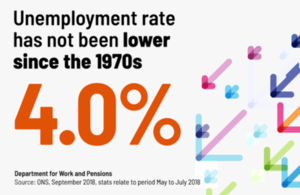Unemployment down by over 1.1 million since 2010

The UK’s unemployment rate of 4.0% has not been lower since the 1970s and the employment rate remains at a near record high 75.5%.
Britain’s unemployment rate has not been lower since the mid-1970s, as official figures released by the Office for National Statistics show it’s fallen to 4.0%, with 1.15 million fewer unemployed people since 2010.
The UK saw a sixth continuous month of real terms pay increases, with regular wages up by 2.9% in July, or 0.5% against CPIH inflation.
Meanwhile the employment rate remains high, at 75.5%, with over 3.3 million more people in work since 2010 and youth unemployment at a record low, falling by over 45% since 2010.
1.45 million more children are living in a home with all adults in work, and the proportion of children living in a household with no working adults has fallen by 33% in the UK since 2010, reaching a record low and taking tens of thousands of children out of poverty.
The Secretary of State for Work and Pensions, Esther McVey, said:
Since 2010 we have delivered significant growth in jobs, and in the last 6 months we’ve seen real terms wage growth.
We haven’t had a lower unemployment rate for over 40 years and I’m especially proud that youth unemployment is at a record low, falling by over 45% since 2010 – opening up career opportunities for our next generation.
In the EU we see unemployment rates over double those of the UK. This government is transforming this country into a great working nation. Ready and prepared for the future challenges after Brexit.
Minister of State for Employment Alok Sharma said:
With unemployment rate still at its lowest level in 43 years, it is good to see that for the sixth month in a row wages have grown faster than inflation helping to put more money in people’s pockets. In the last quarter regular pay is up by 2.9%, 0.5% above inflation.
Households across the country are benefiting from the security of being in work, and with increasing wages and GDP growth of 0.6% last quarter we are delivering an economy that supports working people.
We’ve taken millions out of paying income tax altogether, and by raising the National Living Wage have helped deliver the fastest pay rise for the lowest earners in 20 years.
Today’s (11 September 2018) figures also show:
- older workers also continue to find work as the number of workers aged 50 and over is at a record high of 10.25 million
- the female employment rate remains at a near record high at 71.0%
- since 2010, the vast majority of jobs have been in full-time, permanent roles
- since 2010, there has been an increase of 3.75 million in private sector jobs











Responses